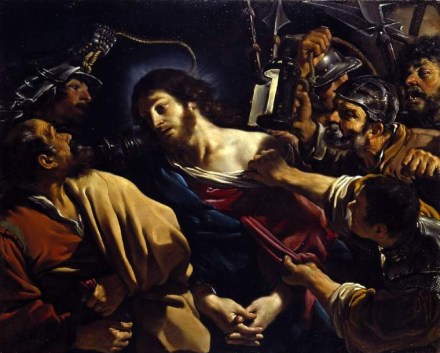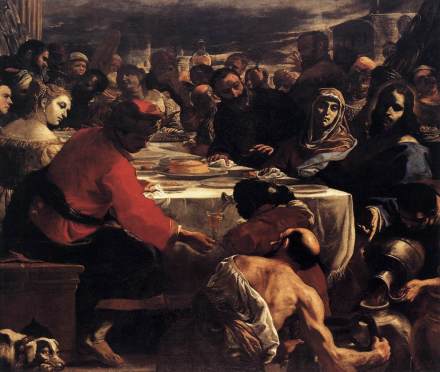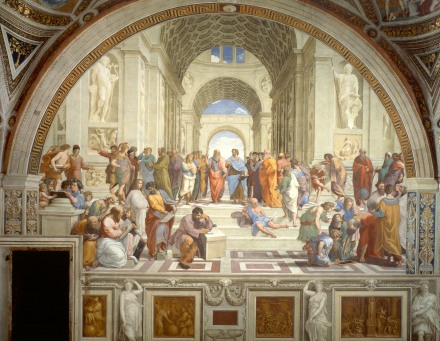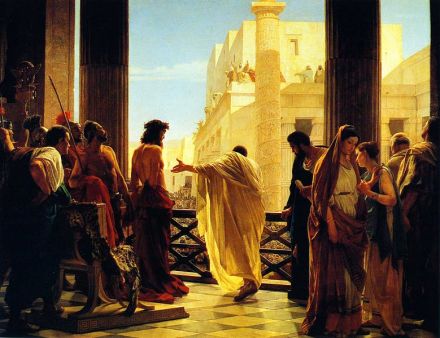The teachings of Jesus of Nazareth did not obey the Torah in an orthodox or familiar way and therefore, some religious groups treated him with contempt. The two main sectarian Jewish groups at this time were the Sadducees and the Pharisees. In the New Testament Jesus uses the characteristics of leaven to denote human behaviour or more specifically a mutual social conduct that permeates through society. For instance, Jesus tells his disciples to beware of the leaven of the Pharisees and the Sadducees [Mk. 8.14-21; Matt. 16.6]. He was symbolically warning them against false doctrine and hypocritical practises. Jesus had acquired a reputation of performing miracles by feeding thousands with a few loaves of bread. The Pharisees doubted his ability, asking him to execute a similar act as evidence that God approved of him. He did not replicate a miracle. On his journey away from the Pharisees with his disciples to the far side of a lake, his followers began complaining about their lack of food. Jesus explained the reasons for his inability to perform a miracle to make more bread in the following passage [Matt. 16,.5-12; Mk. 8.14-21]:
When the disciples crossed over to the other side of the lake, they forgot to take any bread. Jesus said to them, “take care; be on your guard against the leaven of the Pharisees and Sadducees. “
They started discussing among themselves. “He says this because we didn’t bring any bread.”
Jesus knew what they were saying, so he asked them, “Why are you discussing among yourselves about not having any bread? How little faith you have! Don’t you understand yet? Don’t you remember when I broke the five loaves for the five thousand men? How many baskets did you fill? And what about the seven loaves for the four thousand men? How many baskets did you fill? How is it that you don’t understand that I was not talking to you about bread? Guard yourselves from the leaven of the Pharisees and the Sadducees!”
Then the disciples understood that he was not warning them to guard themselves from the leaven used in bread but from the teachings of the Pharisees and the Sadducees.
[Matt. 16. 5-12]
This passage seems to suggest that in fact it was the quality of the leaven that could increase the bread yield or, metaphorically speaking, spiritual fulfilment. Obviously some leaven had better fermenting properties than others and this could be used as an analogue for comparing the quality of philosophical thought. Here Jesus compares the unproductive corrupt leaven or doctrines of the Pharisees with the bountiful yield produced by his own. Perhaps he is also commenting on the rituals involving leaven practiced by the Pharisees and Sadducees.
Politically and religiously, the Sadducees were the most conservative segment of the Jewish population. They were mainly wealthy and aristocratic families that were anxious to stay peaceful with Rome. They strictly followed the Pentateuch and stressed the importance of the Law of Moses (The Torah) in upholding sacrificial rites and regulations governing the priesthood. The main focus of their worship was a temple in Jerusalem where they practiced the rites specified in the Torah, many sacrifices were conducted several times a day.
The temple in Jerusalem had been rebuilt when the Jews returned from exile around 500 BC according to specific instructions laid down in the Pentateuch. The temple consisted of a series of courts leading to an innermost court that only the High Priest could enter. The innermost court was where God was thought to dwell. On a daily basis many sacrifices were performed in the temple; the area was always crowded with priests, Jewish subjects and people selling sacrificial animals. Money-changers were there to provide the coins that were specified by the Torah. Ritual and ceremony had reached a high level of intensity, with even the priests having to fit into the stringent criteria of the Torah. Only those that were direct ascendants of the sons of Aaron could officiate at ceremonies. The High Priest had considerable social status and enjoyed a high amount of authority, being incorporated into government decision-making. He was also head of the Sanhedrin, a court that handled cases that defied the Torah and was recognised by the Romans. This authority was often questioned by the Pharisees and eventually diminished when the temple of Jerusalem was destroyed in 70 AD. The disappearance of the temple marked the disappearance of the Sadducees who were so entrenched in the Temple cult that they couldn’t survive without it.
The Pharisees also followed the Torah but did not concentrate exclusively on the written word in the Pentateuch but other writings and books that were being incorporated into the Old Testament. The Pharisees led the Jewish community to recovery following the destruction of Jerusalem and the Temple around 70 AD during the war with Rome. The Torah excludes certain people viewed as unclean, such as lepers, from society. The fact that Jesus associated with people considered socially and religiously unacceptable, angered the Pharisees and his radical interpretation of the Torah also alienated him from the Sadducees. The fundamental difference between the philosophies of Jesus of Nazareth and the other sects were in obeying the Torah. The Pharisees believed that righteousness consisted within the Torah whereas Jesus believed that the Torah was in itself under the judgement of God. Despite this it is very clear from his teachings that Jesus did not reject the Torah as he was very familiar with its content. For instance when a follower asked him what he must do to inherit eternal life Jesus referred him to the Ten Commandments :
“Good Teacher, what must I do to receive eternal life?”
“Why do you call me good?” Jesus asked him. “No one is good except God alone. You know the commandments: Do not commit murder; do not commit adultery; do not steal; do not accuse anyone falsely; do not cheat; respect yur father and mother.”
[Mk. 10. 17-19]
He also told the man that if he wanted to enter the Kingdom of Heaven he must sell all of his belongings, give the money to the poor and then he would find riches in heaven. When the man walked away dismayed Jesus turned to his followers and told them that it was easier for a camel to pass through the needle’s eye than it was for a rich man to enter the Kingdom of Heaven [Mk. 10. 20-25].
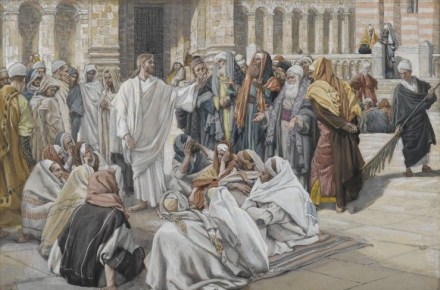
The Pharisees question Jesus. Tissot 1886
There were numerous conflicts between Jesus and the Pharisees, particularly in the association with undesirables, sinners and social outcasts. In response to the Pharisees criticism Jesus explained that if you are not sick than you do not need a physician; I came not to call the righteous, but sinners [Mk. 2.17]. According to the Pharisees, Jesus constantly defiled himself by coming into contact with lepers and outcasts and therefore was ritually unclean and in direct contradiction to the Torah. The Pharisees believed that eating food without first washing the hands was ritually unclean. They and all Jewish people believed that the Torah instructed them to clean all utensils and food before eating. In response to this criticism Jesus argued:
“There is nothing that goes into a person from the outside that makes him ritually unclean. Rather, it is what comes out of a person that makes him unclean.”
[Matt. 15.10-20; Mk. 7.14-23]
In many ways Jesus seems to place the sinners above the self-righteous Pharisees. He explains that those that do not pass judgment on others will be looked upon more favourably in the eyes of God, as described in the Parable of the Pharisee and the Tax Collector:
Jesus also told this parable to people who were sure of their own goodness and despised everybody else. “Once there were two men who went up to the temple to pray: one was Pharisee, the other tax collector. The Pharisee stood apart by himself and prayed, ‘I thank you God I’m not greedy, dishonest, or an adulterer, like everybody else. I thank you do I not right that tax collector over there. I fast two days a week may give you a tenth of all my income.’ But the tax collector stood at a distance and would not even raise his face to heaven, beat his breast and said, ‘God, have pity on me, a sinner!’ I tell you” said Jesus, “the tax collector and not the Pharisee, was in the right with God when he went home. For everyone who makes himself great will be humbled, and everyone who humbles himself will be made great.”
[Lk.18.9-14].
More specifically what Jesus exactly feels about the Torah is explained in the gospel according to Mathew [5.17-20]. He states:
‘Do not think that I have come to do away with the Law of Moses and the teachings of the prophets.’
He goes on to explain that if anyone disobeys the commandments and teaches others to do the same they will be the least in the Kingdom of Heaven. He ends by saying:
‘You will be able to enter the Kingdom of heaven only if you are more faithful than the teachers of the Law and the Pharisees in doing what God requires.’
Jesus disagrees with the methods that the Pharisees use to follow the Torah. The Pharisees had evolved a self-righteous approach to obeying the Torah whereas Jesus was more concerned with spiritual fulfilment and consciousness. This perhaps explains why he compares the corrupting characteristics of leaven to the philosophies of the Pharisees and the Sadducees. He is suggesting that by obeying the Torah according to their teachings, through rules and regulations, you will lose sight of the message that God was initially trying to convey.

